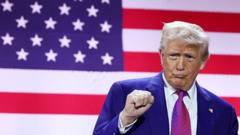In a move that could reshape international trade relations, President Trump announced a 25% tariff on all steel and aluminum imports starting immediately, signaling a potential shift towards a more aggressive tariff policy against America's trading partners.
Trump's Tariff Strategy: New Steel and Aluminum Duties on Imports

Trump's Tariff Strategy: New Steel and Aluminum Duties on Imports
President Trump declares a 25% tariff on steel and aluminum imports, aiming to strengthen the U.S. economy while igniting trade tensions globally.
The President's announcement comes as he plans to propose reciprocal tariffs targeting countries like Europe, Taiwan, and others. This tactic seeks to equalize trade burdens between the U.S. and foreign entities that levy tariffs on American goods. With ongoing tariffs on products from China and a complicated history of negotiations with Canada and Mexico, the administration's approach reflects a broader strategy to protect American industry and labor.
Trump's emphasis on reciprocity highlights a doctrine of tit-for-tat tariffs, which critics argue could lead to further tensions in global trade dynamics and possible violations of World Trade Organization commitments. Amidst these developments, several lawsuits have been filed challenging Trump's extensive use of executive orders, with opposition mounting against his immigration policies and other administration actions.
Furthermore, Trump's proclamation extends beyond tariffs, as he intends to revoke security clearances for several officials tied to the previous administration, prompting a wave of controversy among legal and political circles. As the administration reshapes its priorities, the business and technology sectors are keeping a watchful eye, balancing their interests amidst policy changes that promise to redefine economic landscapes domestically and internationally.
Some industry leaders have hesitated to engage publicly with the administration while navigating the complexities of these emerging measures. As Trump drives these policies forward, the interplay of tariffs, legal challenges, and global economic response will be critical in determining the trajectory of American commerce in the months to come.
Trump's emphasis on reciprocity highlights a doctrine of tit-for-tat tariffs, which critics argue could lead to further tensions in global trade dynamics and possible violations of World Trade Organization commitments. Amidst these developments, several lawsuits have been filed challenging Trump's extensive use of executive orders, with opposition mounting against his immigration policies and other administration actions.
Furthermore, Trump's proclamation extends beyond tariffs, as he intends to revoke security clearances for several officials tied to the previous administration, prompting a wave of controversy among legal and political circles. As the administration reshapes its priorities, the business and technology sectors are keeping a watchful eye, balancing their interests amidst policy changes that promise to redefine economic landscapes domestically and internationally.
Some industry leaders have hesitated to engage publicly with the administration while navigating the complexities of these emerging measures. As Trump drives these policies forward, the interplay of tariffs, legal challenges, and global economic response will be critical in determining the trajectory of American commerce in the months to come.





















